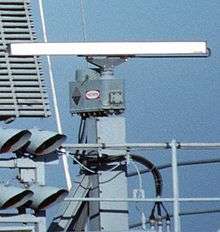Slot antenna


(right) Cross section of similar marine radar antenna, showing slots in waveguide.

A slot antenna consists of a metal surface, usually a flat plate, with one or more holes or slots cut out. When the plate is driven as an antenna by a driving frequency, the slot radiates electromagnetic waves in a way similar to a dipole antenna. The shape and size of the slot, as well as the driving frequency, determine the radiation pattern. Often the radio waves are provided by a waveguide, and the antenna consists of slots in the waveguide. Slot antennas are often used at UHF and microwave frequencies instead of line antennas when greater control of the radiation pattern is required. Slot antennas are widely used in radar antennas, for the sector antennas used for cell phone base stations, and are often found in standard desktop microwave sources used for research purposes. A slot antenna's main advantages are its size, design simplicity, and convenient adaptation to mass production using either waveguide or PC board technology.
The slot antenna was invented in 1938 by Alan Blumlein, while working for EMI. He invented it in order to produce a practical type of antenna for VHF television broadcasting that would have horizontal polarization, an omnidirectional horizontal radiation pattern and a narrow vertical radiation pattern.[1][2]
See also
References
- ↑ Blumlein, Alan (1938-03-07), "Improvements in or relating to high frequency electrical conductors or radiators", British patent no. 515684
- ↑ Burns, Russell (2000). The life and times of A D Blumlein. Institution of Engineering and Technology. ISBN 0-85296-773-X.
External links
- Slot Antennas www.antenna-theory.com